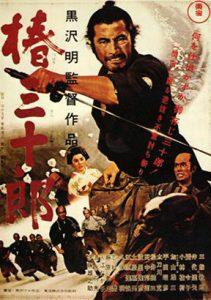Director: Akira Kurosawa
Writer: Ryuzo Kikushima, Akira Kurosawa
Cast: Toshiro Mifune, Tatsuya Nakadai, Keiju Kobayashi, Yuzo Kayama, Reiko Dan, Akihiko Hirata, Takashi Shimura, Kamatari Fujiwara, Takako Irie, Masao Shimizu
Running Time: 96 min.
By Mairosu
After Yojimbo proved to be a huge commercial hit, messrs Kurosawa and Mifune teamed up for another humorous caper about the wisecracking nameless ronin, and this time with equal success. Sanjuro is admittedly more light-hearted and has more action than the faux-serious Yojimbo, and those characteristics, along with the short running time, make it probably the best Kurosawa film for the newcomers to his oeuvre.
This time, our reluctant hero – the scruffy ronin who likes to call himself “Sanjuro” (Mifune) with a random plant serving as his family name (in Yojimbo he’s Sanjuro Mullberry (Kuwabatake), here he’s Sanjuro Camelia (Tsubake) – is getting busy helping some young samurai solve a case of a corrupt superintendent and a loyal chamberlain (for the speaking impaired of you, “chamberlain” means “high ranking court official”). The superintendent has taken the chamberlain captive as a result of one youngster’s faux pas, and is just about ready to send in his troops to finish off the young bucks, but – but – there comes Sanjuro to the rescue. Literally out of the blue, Sanjuro joins the fray and first brainstorms a way out, then fends off all the guards and then gets fully involved in the rescue plot.
This time, unlike in Hidden Fortress, it is high adventure. I found Sanjuro much more pleasing on a pure arcade level, as the film is filled with wisecracks and action sequences (which are on a better level than in Yojimbo, and you even hear the swordplay sound effects here and there). Again, director abandons his habit of implementing social commentary throughout the film and just concentrates on the fun ride that this film proved to be. The only social note might be that again, individual thinks better than a group, but that’s nothing which is too purposely hammered into your head. There is however a hilarious element to the whole story, and that is the appearance and the dialogue of Chamberlain’s wife and daughter, who are a total contrast from the usual “damsel in distress” – the old lady is pretty calm and composed throughout the whole of film, and still manages to dispense some pearls of wisdom to Sanjuro such as “killing is a very bad habit”. The funniest moment is when Sanjuro is supposed to give a sign to the rest of the samurai by sending white camellias down the stream – when that happens, everyone jumps alert at the good guys’ stronghold, while the women just charmingly react with “oooh, how nice !” (referring to the bunch of camellias floating down the stream).
There is an interesting debate going on about the time period in which Sanjuro is set. Most people have noticed that, unlike Yojimbo, Sanjuro is set in a more serene and socially stable period – which can be observed on the garments of the protagonists. So, basically, what we have here is the same character – of same age, “thirty, going to forty” – in a time period two decades prior to Yojimbo. Someone at IMDB pitched the idea that Sanjuro is actually just a roaming folk hero and a protective spirit, who intervenes whenever something goes awry, and that sounds like the most likely solution one could subscribe to. Unless you think that Mifunes grow on a tree in Japan, which again, might not be that unlikely.
I’ll have to warn the potential viewers about the bloody final duel which occurs between Mifune and Tatsuya Nakadai, who just like in Yojimbo reprises the role of the main villain (this time much less flamboyant and without a firearm). Two of them engage in a very brief duel on a plain minutes before the ending credits, and you’re advised not to even blink when they assume their fighting positions – if you’re not careful, the shot might breeze by you and you might miss one of the greatest climaxes in the Japanese contemporary cinema (a subjective opinion obviously), right up there with the arrow salvo of Throne of Blood and Watanabe’s last breath in Ikiru.
So, so far, I saw six Kurosawa films in seven days, and the top list can be ranked like this as of now:
1. Ikiru
2. Throne of Blood
3. Sanjuro
4. Yojimbo
5. Stray Dog
6. Hidden Fortress
And to think that all six are actually quality work. I have nothing against Hidden Fortress really, it’s a classy film in its own right and I gave it three stars, but I liked Sanjuro, Yojimbo and Stray Dog just a shade better. Well, in all honesty, I like Sanjuro a few shades better than Yojimbo, Stray Dog and Hidden Fortress, hence…
Mairosu’s Rating: 8.5/10



